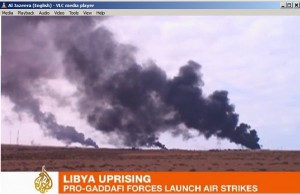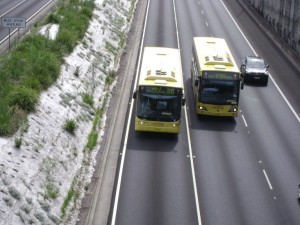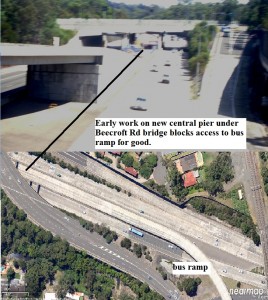It is unbelievable. Transurban started work on the M2 widening in Sydney by blocking access lanes for a bus ramp to a major railway station in the suburb of Epping. And the NSW opposition – under election pressure to “solve” congestion problems on toll-ways – promises to widen the M5 from 4 lanes to 6 lanes.

This new construction site sits right on the bus lanes. Two rows of concrete columns will be replaced by one central pier, blocking any future public transport solution
They fail to grasp the seriousness of irreversible, fundamental and historic changes now happening in North Africa and the Middle East which have started to impact on oil supplies. Whether we like it or not, the era of oil deals between oil rich despots and the West to supply cheap and plentiful oil is coming to an end. In year 6 of peak oil, converging trends of demographic changes, geo-political shifts, socio-economic crises and general popular discontent, we are entering a new phase in which Shia unrest in Bahrain and now also in Saudi Arabia is coming close to gaint oil fields between Ghawar and Qatif. This is used by Iran to destabilize neighbouring countries and increase its influence in the region as the US is planning to withdraw its last troops from Iraq by the end of this year.
Our naïve decision makers have not understood that this will end our car culture sooner than we think because there is no time to transition the car fleet to green cars, yellow cars or electric cars. Worse, still, we are not converting our truck fleet – bringing food to our cities – to CNG and/or LNG.
 Internal fights over oil between the Ras Lanuf refinery and the Al Sidr tank farm
Internal fights over oil between the Ras Lanuf refinery and the Al Sidr tank farm
If unrest impacts on Saudi oil supplies we are going to have a number one oil crisis very soon, including physical shortages, rendering all toll-way projects obsolete over night.
Saudis mobilize thousands of troops to quell growing revolt
5/3/2011
Saudi Arabia was yesterday drafting up to 10,000 security personnel into its north-eastern Shia Muslim provinces, clogging the highways into Dammam and other cities with busloads of troops in fear of next week’s “day of rage” by what is now called the “Hunayn Revolution”.
An indication of the seriousness of the revolt against the Saudi royal family comes in its chosen title: Hunayn. This is a valley near Mecca, the scene of one of the last major battles of the Prophet Mohamed against a confederation of Bedouins in AD630. The Prophet won a tight victory after his men were fearful of their opponents. The reference in the Koran, 9: 25-26, as translated by Tarif el-Khalidi, contains a lesson for the Saudi princes: “God gave you victory on many battlefields. Recall the day of Hunayn when you fancied your great numbers. [Ref…]
Oil crunch inevitable as Arab revolts intensify
5/2/2011
Mr Abi Ali [from UK based Exclusive Analysis] said the Middle East was now in the vortex of multiple uprisings that will create turmoil for years and destabilise oil supply for a long time. “The Arab world is not going to start behaving like the Swiss,” he said. [Ref…]
Bahrain and the Battle Between Iran and Saudi Arabia
8/3/2011
Unlike Libya, where the effects are primarily internal, the events in Bahrain clearly involve Saudi, Iranian and U.S. interests. Bahrain is also the point where the Iranians have their best chance, since it is both the most heavily Shiite nation and one where the Shiites have the most grievances. But the Iranians have other targets, which might be defined as any area adjoining Saudi Arabia with a substantial Shiite population and with American bases. This would include Oman which the United States uses as a support facility; Qatar, headquarters of U.S. Central Command and home to Al Udeid Air Base; and Kuwait, the key logistical hub for Iraqi operations and with major army support, storage and port facilities. All three have experienced or are experiencing demonstrations. Logically, these are Iran’s first targets…..
Those [Iranian] interests divide into three parts:
- eliminating foreign powers from the region to maximize Iranian power,
- convincing Saudi Arabia and other countries in the region that they must reach an accommodation with Iran or face potentially dangerous consequences, and
- a redefinition of the economics of oil in the Persian Gulf in favor of Iran, including Iranian participation in oil projects in other Persian Gulf countries and regional investment in Iranian energy development. [Ref…]
Energy Subsidies at $80 bn – Oil Minister
Iran’s Oil Minister Masoud Mir-Kazemi said today the government’s subsidies of energy products had reached nearly $80 billion a year. [Ref…]
Iranian budget and statistics for 2011
In 2010 Iran sold oil in the amount of 64 bln dollars, the income generated from gas condensate, petrochemistry and non-oil exports for the last 10 months totalled 21.5 billion dollars. [Ref…]
This means Iranian exports of hyrdocarbons in 2010 were hardly sufficient to pay for energy subsidies. It illustrates that Stratfor’s “re-definition of oil-economics” means that Iran needs higher oil prices to balance their budget. Each $10 increase in oil price yields 2.2 mb/d exports x $10 x 365 = $ 8 bn pa
But here down-under, politicians think all this is of no relevance to Australia, as if we were on a different planet. They continue with projects increasing our oil-addiction:
Barry O’Farrell will bust the M5 congestion
9/3/2011
BARRY O’Farrell will today make his biggest transport promise of the election campaign so far – committing to a $350 million widening of the clogged M5 motorway from four to six lanes. [Ref…]
That brings us back to Sydney’s problems on the M2:
 Diesel buses running on the M2
Diesel buses running on the M2
In the case of diesel shortages diesel buses from the North West to the CBD will have to terminate at the rail hub of Epping, being forced by circumstances to save on fuel. Then the bus ramp will be urgently needed. It is plain stupidto start the current foundation work on those bus lanes

Transurban starts work on the M2 under the Beecroft Rd bridge just as another toll-way, the $ 3bn Clem7 tunnel in Brisbane, has gone into receivership, tentatively valued at only $650 m. [Ref…]
This web site will closely follow the financial drama now evolving around the doomed M2 widening, comparing the progress of work against the oil reality in the Middle East. 1,000 of readers around the world will watch it.
The above ratio of investment and ultimate asset value in the Clem7 example gives us an idea what the value of the M2 widening work will be when Transurban goes into receivership. But this is not only about investors and shareholders losing money. The way things are going, long-distance commuting in Sydney will become dysfunctional, with incalculable consequences for the economy.
Conclusion and what to do
Work on the M2 for a 3rd lane should be immediately stopped and contracts be re-negotiated to improve bus lanes on the M2. Governments, banks and Transurban would have to:
- Re-assess the future oil supply situation in North Africa and the Middle East
- Calculate what that means for the cash flow of the company and for the financial viability of the M2 widening project in particular
- Analyse the increased risk of obtaining the remaining $275 m to complete the widening if the evolving oil shock should spark another credit crunch as already happened in 2008
- And most importantly work out alternative transport solutions like electric trolley buses and light rail on the M2
In short, it is now very urgent that decision makers work on and implement a strategy of getting us away from oil as fast as possible and before things get out of control in the Middle East.